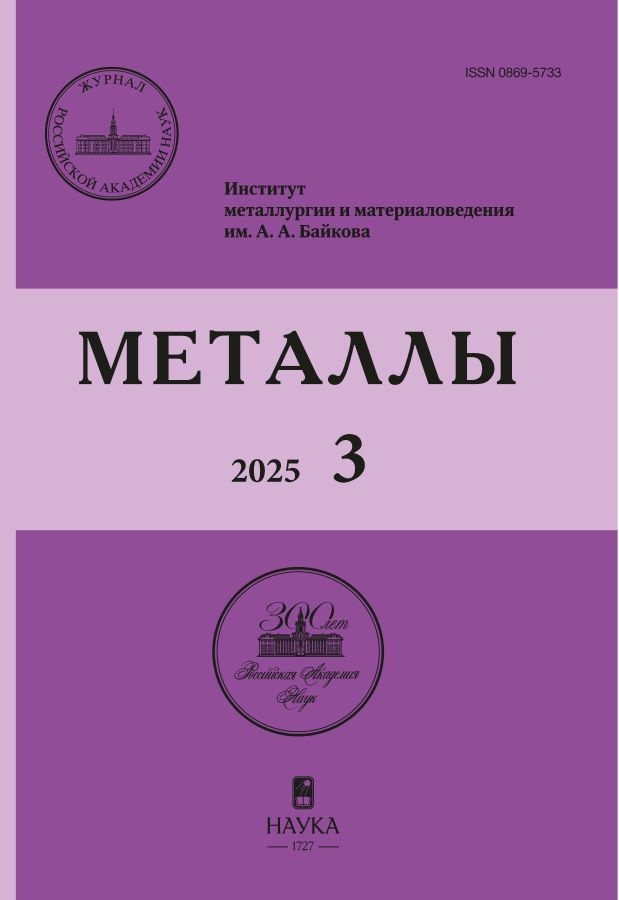Interaction of Dispersed Cobalt with Molten Copper under Low-Frequency Vibration
- Authors: Bodrova L.E1, Goyda E.Y.1, Shubin A.B.1, Fedorova O.M.1
-
Affiliations:
- Institute of Metallurgy (IMET), Ural Branch, Russian Academy of Sciences
- Issue: No 6 (2023)
- Pages: 81-89
- Section: Articles
- URL: https://ruspoj.com/0869-5733/article/view/654827
- DOI: https://doi.org/10.31857/S0869573323060101
- EDN: https://elibrary.ru/EKXQTG
- ID: 654827
Cite item
Abstract
The possibility of increasing the hardness of a Co–Cu binder in single-stage production of WC–Cu–Co composites using pre-solidification low-frequency vibration (LFV) is investigated. Cu–Co and WC–Cu–Co alloys are fabricated by reactive infiltration of liquid copper into uncompacted WC and Co powders under LFV of their compositions (80 Hz for 10 min at 1300–1350°C). Their phase and chemical compositions, structure, and hardness have been studied. We are the first to experimentally show that metastable formations (frozen immiscibility regions of two liquids) are the precursors of (Co) dendrites and have the same composition with them. The cobalt distribution over the height of Cu–Co alloy ingots and over phase components is shown to depend on the cobalt content, the effect of vibration, the geometric arrangement of initial component layers, and the temperature. The optimum conditions for achieving a uniform cobalt distribution over the melt have been determined. Cobalt is shown to ensure precipitation hardening of the Cu–Co metal binder due to the formation of (Cu) solid solutions already at the stage of synthesis of Cu–Co and WC–Cu–Co alloys. Moreover, the potential for additional hardening by subsequent heat treatment or by changing cooling conditions is still incompletely fulfilled.
About the authors
L. E Bodrova
Institute of Metallurgy (IMET), Ural Branch, Russian Academy of Sciences
Email: bodrova-le@mail.ru
Yekaterinburg, Russia
E. Yu. Goyda
Institute of Metallurgy (IMET), Ural Branch, Russian Academy of Sciences
Email: bodrova-le@mail.ru
Yekaterinburg, Russia
A. B. Shubin
Institute of Metallurgy (IMET), Ural Branch, Russian Academy of Sciences
Email: bodrova-le@mail.ru
Yekaterinburg, Russia
O. M. Fedorova
Institute of Metallurgy (IMET), Ural Branch, Russian Academy of Sciences
Author for correspondence.
Email: bodrova-le@mail.ru
Yekaterinburg, Russia
References
- Левашов, Е.А. История отечественных твердых сплавов / Е.А. Левашов, В.С. Панов, И.Ю. Коняшин // Изв. вузов. Порошковая металлургия и функциональные покрытия. 2017. №3. С.14-21. DOI: dx.doi.org/10.17073/1997-308X-2017-3-14-21.
- Konyashin, I. Wettability of tungsten carbide by liquid binders in WC-Co cemented carbides: Is it complete for all carbon contents? / I. Konyashin, A.A. Zaitsev, D. Sidorenko, E.A. Levashov, B. Ries, S.N. Konischev, M. Sorokin, A.A. Mazilkin, M. Herrmann, A. Kaiser // Intern. J. Refract. Metals and Hard Mater. 2017. Р.134-148.
- Loginov, P.A. In situ observation of hardmetal deformation processes by transmission electron microscopy: in 2 parts. Pt. II: Deformation caused by tensile loads / P.A. Loginov, A.A. Zaitsev, I. Konyashin, D.A. Sidorenko, A.S. Orekhov, E.N. Avdeenko, E.A. Levashov // Intern. J. Refract. Metals and Hard Mater. 2019. https://doi.org/10.1016/j.ijrmhm.2019.105017.
- Garcia, J. Cemented carbide microstructures: a review /j. Garcia, V.C. Cipre¢s, A. Blomqvist, B. Kaplan // Intern. J. Refract. Metals & Hard Mater. 2019. Р.40-68. https://doi.org/10.1016/j.ijrmhm.2018.12.004.
- Dias, M. WC-Cu thermal barriers for fusion applications / M. Dias, F. Guerreiro, E. Tejado, J.B. Correiac, U.V. Mardolcar, M. Coelho, T. Palacios, J.Y. Pastor, P.A. Carvalho, E. Alves // Surf. Coat. Technol. 2018. Р.222-226. https://doi.org/10.1016/j.surfcoat.2018.02.086.
- Silva, V.L. Copper wettability on tungsten carbide surfaces / V.L. Silva, C.M. Fernandes, A.M.R. Senos // Ceramics Intern. 2016. P.1191-1196. Available online at www.sciencedirect.com.
- Shinoda, Yu. Development of creep-resistant tungsten carbide copper cemented carbide / Yu. Shinoda, Yu. Yanagisawa, T. Akatsu1, F. Wakai1, H. Fujii // Mater. Trans. 2009. V.50. №6. Р.1250-1254. - (Special Issue on Joining Technology for New Metallic Glasses and Inorganic Materials). doi: 10.2320/matertrans.ME20080.
- Cardoso, J.P. WC-Cu (AlSI304) composites processed from high energy ball milled powders /j.P. Cardoso, J. Puga, A.M. Ferro Rocha, C.M. Fernandes, A.M.R. Senos // Intern. J. Refract. Metals & Hard Mater. 2019. Art.104990. https://doi.org/10.1016/j.ijrmhm.2019.104990.
- Bodrova, L.E. Smart-microstructures of composites for electrical contacts with frameless packing of Cr and W in copper / L.E. Bodrova, S.Yu. Melchakov, A.B. Shubin, E.Yu. Goyda // Trans. Nonferrous Met. Soc. China. 2021. V.31. P.2773-2786. doi: 10.1016/S1003-6326(21)65692-3.
- Гойда, Э.Ю. Дугостойкость на воздухе сплавов WС-Cr3С2-Сu с бескаркасной упаковкой карбидов / Э.Ю. Гойда, И.О. Гилев, Л.Е. Бодрова, А.Б. Шубин // Перспективные материалы. 2022. №12. С.20-31. doi: 10.30791/1028-978X-2022-12-20-31.
- Goyda E.Yu. Arc Resistance in Air of WC-Cr3C2-Cu Alloys with Frameless Packing of Carbides / E.Yu. Goyda, I.O. Gilev, L.E. Bodrova, A.B. Shubin // Inorgan. Mater.: Appl. Res. 2023. V.14. №2. Р.479-487. ISSN 2075-1133. doi: 10.1134/S2075113323020168.
- Бодрова, Л.Е. Структура и свойства слоистых композитов WC-Cu, полученных в условиях вибрации / Л.Е. Бодрова, Э.Ю. Гойда, А.Б. Шубин, О.А. Королев // Перспективные материалы. 2023. №9.
- Диаграммы состояния двойных металлических систем: справочник: в 3 т. / под ред. Н.П. Лякишева. - М.: Машиностроение, 1997. Т.2. 1024 с.
- Когтенкова, О.А. Фазовые переходы смачивания границ зерен в перитектических сплавах медь-кобальт / О.А. Когтенкова, А.Б. Страумал, Н.С. Афоникова, А.А. Мазилкин, К.И. Колесникова, Б.Б. Страумал // ФТТ. 2016. Т.58. Вып.4. С.721-724.
- Tolmachev, T.P. Mechanical alloying and fracture features of non-equilibrium Cu-Co alloys / T.P. Tolmachev, V.P. Pilyugin, A.M. Patselov, A.I. Ancharov, A.V. Inozemtsev // Diagnostics, Resource and Mechan. Mater. Struct. 2018. Is.6. P.18-26.
- Исхаков, Р.С. Сплавы Co-Cu, полученные механическим сплавлением из порошковых прекурсоров с различной контактной поверхностью и энергонасыщенностью / Р.С. Исхаков, Л.А. Кузовникова, Е.А. Денисова, С.В. Комогорцев, А.Д. Бадаев // ФММ. 2009. Т.107. №5. С.513-519.
- Ignat'ev, E. Low frequency technique for alloys production / E. Ignat'ev, E. Pastukhov, L. Bodrova. - Saarbrucken: LAP LAMBERT Akad. Publ., 2013. 170 p.
Supplementary files











